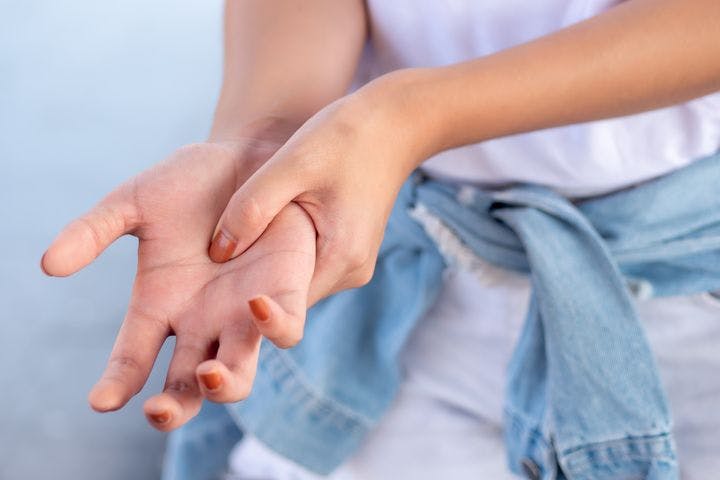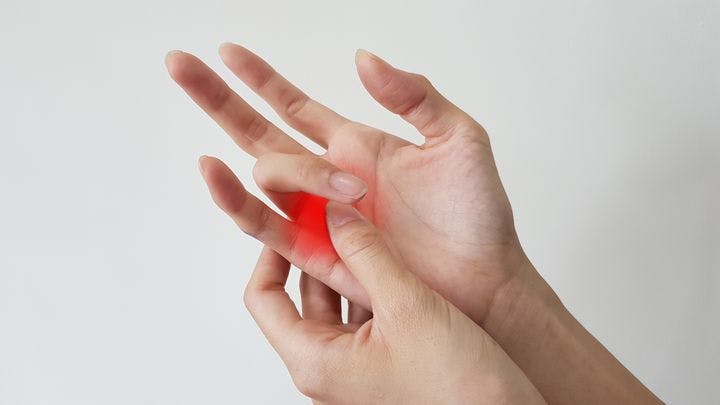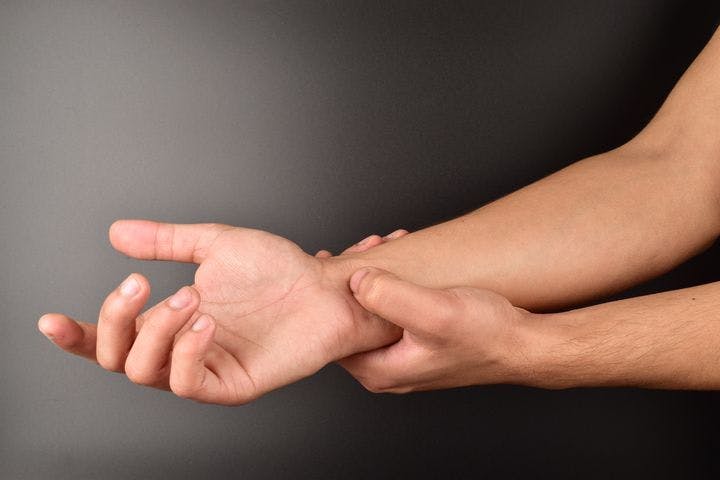6 Trigger Finger Treatments for Stiff and Painful Fingers
Published | 6 min read
Is your finger stuck in a painful bent position? This is known as trigger finger. Check out these treatments for immediate relief.

Trigger finger might sound like a tongue twister, but it’s a great example of how machine-like the human body is. Our hands and fingers are part of a complex mechanical system of “pulleys and strings” in the form of tendons, ligaments, muscles, and bones that allow us to move freely. Just like machines, sometimes this system can malfunction, causing your fingers to become stiff and painful. Find out what the causes of this condition are and six trigger finger treatments you can try at home.
What Causes Trigger Finger

In trigger finger, the affected finger, which is often the ring finger or the thumb (though it can affect any finger) – is unable to straighten on its own. There is usually pain at the base of the finger in the palm.
When you have trigger finger, also known as stenosing tenosynovitis, the “pulley” at the base of your finger and your tendon sheath are not working optimally. This causes your flexor tendon to “catch” in its sheath. Your finger gets stuck in a bent position, unable to straighten on its own. This condition can be very painful.
There are three ways the flexor tendon can catch and be unable to glide normally in its sheath:
- The tendon swells, causing it to be larger than usual
- The tendon sheath is inflamed, causing it to be too narrow for the tendon
- The A1 pulley is swollen or thickened, making it harder for the tendon to glide
People in occupations or who perform activities involving repetitive forceful movements, such as farmers, musicians, industrial workers and housekeepers, can develop this condition. Trigger finger typically affects adults in their 40s or older. It occurs in women more often than men — and in about 2% of the general population.
In the population of those with diabetes, the incidence increases to about 17%. Other risk factors for developing trigger finger include conditions that affect the joints such rheumatoid arthritis, gout, amyloidosis, an underactive thyroid, carpal tunnel syndrome, Dupuytren’s contracture and De Quervain’s disease.
In Traditional Chinese Medicine (TCM), trigger finger is categorised as part of a larger category of conditions referred to as tendon paralysis. “Pathologically, this condition is associated with blocked meridians, poor qi and blood flow, and Qi Stagnation caused by Blood Stasis,” explains TCM Physician Ignatius Ooi.
Trigger Finger Treatments
Fortunately, the condition is highly treatable. Treatments focus on releasing the stuck tendon and addressing the pain associated with the issue. In TCM, the focus is on restoring optimal flow of qi through the body’s meridians as well as enhancing the body’s own ability to heal the condition.
1. Rest
This may be obvious, but at the first sign of a dull pain and decreased range of motion signalling the possibility of trigger finger, make sure to cease the activity and let your fingers rest. This may be difficult for people whose occupations depend on their ability to use their fingers. But not resting will only make the condition worse, leading to more severe damage that could affect your livelihood permanently.
2. Splinting
The main complaint of trigger finger is the inability to straighten the bent finger. This is especially after long period of resting, such as when sleeping at night. Your doctor may recommend putting on a finger splint that prevents the compromised flexor tendon from bending your finger throughout the night.
Keep in mind that when you wake up in the morning and remove the splint, it may take some time to get your finger to move again. Take it slow. Gently and lightly massage the base of the finger to slowly loosen the joint and muscles.
3. Anti-inflammatory medicine
A way to find some relief is to reduce the swelling and reduce the pain response by using painkillers. For relatively immediate pain relief, you can take non-steroidal anti-inflammatory drugs (NSAIDs) such as ibuprofen.
If this still doesn’t help much, a corticosteroid injection may help. This is a more direct and slightly invasive treatment due to the injection at the sight of the inflammation. It is usually effective at reducing swelling, though it could take a few days for a positive effect to take place. Work with a trained physician, but note that if you have diabetes, you may not benefit much from a steroid injection. Instead, you might experience a short-term rise in blood sugar.
4. Acupressure

The TCM approach to trigger finger is focused on restoring the flow of qi by optimising the meridians. This removes Blood Stasis and Qi Stagnation. Consider doing some acupressure on yourself at the first sign of a stiffening and sensation of catching or locking in the tendon. Physician Ooi shares the pressure points that can help:
- Qu chi (LI11, 曲池)
- Yang chi (SJ-TE4, 阳池)
- Pian li (LI6, 偏歴)
- He gu (LI4, 合谷)
- Lie que (LU7, 列缺)
- Thenar (the fleshy muscle at the base of the thumb)
- Ashi point: “Ashi” is similar in concept to “trigger points” that refer to the tender points in the affected area
“Rub the point repeatedly with the thumb or thenar eminence (the ball of the thumb), until the affected spot feels warm. Spend 15 to 20 minutes for each treatment once a day. The amount of stimulation should be determined by the person’s preference or the condition. The massage can be followed by a ten-minute warm compress,” Physician Ooi further instructs.
5. TCM Herbs
TCM approaches also focus on helping the body heal itself. One of the ways to do this is through herbal medicine. Physician Ooi shares a quick recipe using coix seeds (yi yi ren, 薏苡仁), also commonly known as Job’s Tears, to remove stasis and improve blood circulation:
- Add appropriate amount of water to 50g of coix seeds and 50g of rice.
- Boil until it turns into porridge.
- Take one small bowl every morning and night for about two weeks and monitor progress.
You may also consider other potential herbs that can help strengthen the body, such as Acanthopanax notoginseng found in Tian qi (田七) pills. It is usually taken twice per day after meals. As always, work with a licensed and experienced TCM practitioner rather than self-medicating.
6. Surgery
If other treatments are ineffective and the severity of your condition worsens, talk to your doctor about the possibility of surgery. There are two types of surgery commonly used to treat severe trigger finger. Open surgery, called Tenolysis surgery, is an incision at the base of the affected finger. It essentially releases the A1 pulley to allow the tendon to free up. It requires healing time due to the incision.
Another type of surgery is percutaneous surgery. It uses a needle that punctures through the skin and ligament to release the tendon at the same A1 pulley location. This is aided with ultrasound imaging that enables the surgeon to find the right location.
If surgery is your last resort, do work with your doctor and healthcare provider to determine the most suitable type for your condition.
Losing the ability to control movement in your finger is not only frustrating but also painful. Fortunately, trigger finger treatments are relatively straightforward and usually effective.
References
- National Health Service (NHS) – United Kingdom. 2022. Trigger Finger. [Accessed 8 May 2022].
- American Academy of Orthopaedic Surgeons. 2018. Trigger Finger. [Accessed 8 May 2022].
- American Society for Surgery of the Hand. Trigger Finger. [Accessed 8 May 2022].
- Cleveland Clinic. 2019. Trigger Finger and Trigger Thumb. [Accessed 8 May 2022].
- StatPearls. 2021. Trigger Finger. [Accessed 8 May 2022].
- Medical Acupuncture. 2018. How Do You Treat Trigger Finger in Your Practice? [Accessed 8 May 2022].
- World Journal of Acupuncture-Moxibustion. 2016. The historical source of “Trigger Points”: Classical Ashi points. [Accessed 8 May 2022].
Share this article on
Was This Article Useful to You?
Reviews (2)
I’m very interested in using acupressure to try and treat my trigger finger. What I would have liked to have seen more of was showing the acupressure points also on a regular picture of the hand and arm as well as the one shown using the skeletal system. I had a hard time distinguishing the LI 6 and the LU 7 points.
No. Need specific massage techniques for palm and joint of middle finger











